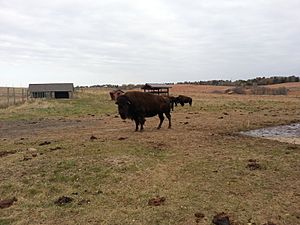Pioneers Park Nature Center facts for kids
Pioneers Park Nature Center is a special place in Lincoln, Nebraska, where you can explore nature. It was created in 1963 and covers about 668-acre (2.70 km2) of land. The park is run by the Lincoln Parks and Recreation Department and is a great spot to learn about local wildlife and plants.
Contents
About the Nature Center
The Nature Center is found in the southwest part of Pioneers Park. This amazing natural area includes land on both sides of Haines Branch Creek. You can explore eight miles of trails, discover several ponds, and visit two special buildings with exhibits. There are also fun activities happening all year round!
What You Can See and Do
The Chet Ager Building has many cool exhibits, including live animals. You might see a bee skep, which is a traditional beehive, and a big herb garden right outside.
The newer Prairie Building shows off prairie plants and more live animals. It also has a large room for meetings. This building is special because it uses eco-friendly features like straw bale construction and a green roof. It even has a special "LEED Silver" certification, meaning it's very good for the environment.
You can walk or hike on four miles (6 km) of trails that go through native Nebraska prairie grasslands, woodlands, and wetlands. Along the trails, you can see herds of bison, along with elk, white-tailed deer, turkey vultures, and owls living in their natural homes.
The Nature Center is open all year. It offers many fun programs like school trips, preschool activities, scout badge work, nature day camps, and even night hikes. They also have many special events.
History of the Park
The Pioneers Park Nature Center has grown a lot over the years.
Early Days and Growth
In the 1930s, three ponds were dug in the area to attract waterfowl, which are birds that live near water. In 1963, about 40 acres around these ponds became the Chet Ager Bird and Wildlife Nature Study Sanctuary. The Chet Ager building was finished the next year, right by one of the ponds.
In 1975, the sanctuary added sixteen more acres of city land that used to be farms. This new land was along the Haines Branch Creek and was connected to the original sanctuary by a cool suspension bridge over the creek.
Focus on Native Wildlife
By 1984, people started planning to make the sanctuary even better by bringing back and protecting native ecosystems and showing off local wildlife. Before this, the sanctuary was next to a drive-through zoo that had animals from other countries. Now, where that zoo used to be, you can find the bison, deer, elk, and raptors (birds of prey).
Starting in 1985, the Chet Ager facility took over the 80 acres where the zoo was. The animals from other countries were moved to other zoos. In their place, the Nature Center brought in native wildlife like foxes, deer, turkeys, bison, and elk.
New Buildings and Land Additions
The Prairie Building, surrounded by a restored tallgrass prairie called the Hands-on Prairie, was built in different stages during the 1990s and early 2000s. In 1996, the Robert Powell family gave 56 acres to the Nature Center. This land was named Verley Prairie to honor Robert Powell's uncle, Ben Verley.
Between 1997 and 2005, David and Bonnie Martin sold or gave a total of 465 acres of pastureland to the Nature Center. This land is split into three parts. The first 157 acres, added in 1997, became Martin Prairie. Hilltop Prairie was formed from 80 acres bought in 1999. The last 228 acres, bought in 2005, are called Foundation Prairie. These additions helped the Nature Center grow a lot!
Geography of the Center
The main office building at the Nature Center, the Prairie Building, is located at 40°46′28″N 96°46′36″W / 40.77444°N 96.77667°W. The 668 acres of land at the Nature Center include different types of natural areas. You can find tallgrass prairies, lowland prairies, wetlands, woodlands, and streams. Almost 500 acres of this land is tallgrass prairie.
How the Land is Managed
The Pioneers Park Nature Center Land Management Crew takes care of the park every day. They keep the trails in good shape, maintain the buildings, and remove invasive trees and weeds. Invasive plants are those that grow too much and can harm native plants, like thistles, garlic mustard, and leafy spurge.
Every year, the Land Management Crew works with other groups to do "prescribed burns." This means they carefully set small fires to help the prairie stay healthy and grow. They also use cattle grazing as a way to help conserve the prairies.
The bison, elk, and white-tailed deer are looked after by the Lincoln Parks and Recreation Southwest District.


